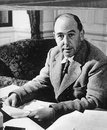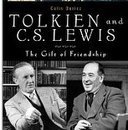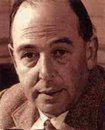David C. Downing's Blog, page 13
November 30, 2011
INKLINGS Q & A: How did C. S. Lewis come up with the name for one of his most be...
INKLINGS Q & A: How did C. S. Lewis come up with the name for one of his most beloved Narnia characters, Puddleglum?
A: In his scholarly survey "English Literature in the Sixteenth Century, Excluding Drama" (1954), Lewis mentioned a minor sixteenth-century poet named John Studley, whose word choices were sometimes unintentionally comical. Studley used terms such as "frostyface" and "topsy turvy" in passages meant to be serious, and he described the hellish river Styx as a "puddle glum." Lewis said he couldn't help but smile over the phrase. And he can't help but make his readers smile when he turns it into the name of his morose Marshwiggle in The Silver Chair--Puddleglum.

A: In his scholarly survey "English Literature in the Sixteenth Century, Excluding Drama" (1954), Lewis mentioned a minor sixteenth-century poet named John Studley, whose word choices were sometimes unintentionally comical. Studley used terms such as "frostyface" and "topsy turvy" in passages meant to be serious, and he described the hellish river Styx as a "puddle glum." Lewis said he couldn't help but smile over the phrase. And he can't help but make his readers smile when he turns it into the name of his morose Marshwiggle in The Silver Chair--Puddleglum.

Published on November 30, 2011 06:56
November 23, 2011
INKLINGS Q & A: The Crack of Doom is certainly one of the most awe-inspiring set...
INKLINGS Q & A: The Crack of Doom is certainly one of the most awe-inspiring settings in LOTR. But how is the name of this terrifying place based on a whimsical pun by Professor Tolkien?
A: The phrase "crack of doom" means Day of Judgment, the crack being a loud noise, such as we use in "a crack of thunder." The phrase is most famously used by the witches in Shakespeare's MacBeth. Tolkien adapted the term to describe a physical crack, a volcanic fissure in Mount Doom, where Frodo must journey to destroy the One Ring.

A: The phrase "crack of doom" means Day of Judgment, the crack being a loud noise, such as we use in "a crack of thunder." The phrase is most famously used by the witches in Shakespeare's MacBeth. Tolkien adapted the term to describe a physical crack, a volcanic fissure in Mount Doom, where Frodo must journey to destroy the One Ring.

Published on November 23, 2011 06:39
November 21, 2011
In LOOKING FOR THE KING, two young Americans visit Royston Cave in Hertfordshire...
In LOOKING FOR THE KING, two young Americans visit Royston Cave in Hertfordshire to inspect 13th century wall carvings apparently created by Knights Templar in hiding. Stories have persisted for centuries of fabulous hidden treasures left by the Knights in this region. In 2005 a group called Subterranea Britannica proposed to explore hidden tunnels and caves in Hertfordshire, but were deterred after receiving anonymous threats. Anything in these carvings look like a treasure map to you?

Wall Photos

Wall Photos
Published on November 21, 2011 05:58
November 19, 2011
INKLINGS FACT: C. S. Lewis is often referred to as a "theologian," but he was no...
INKLINGS FACT: C. S. Lewis is often referred to as a "theologian," but he was not comfortable with that label. He preferred to call himself a "mere Christian." Once when he was asked a technical question about St. Paul's theology in the book of Romans, Lewis replied, "You are trying to use a rough knife as a razor. I'm not qualified to give the guidance you need. These are things I need to learn not teach" (Letters, II, 941).

Wall Photos

Wall Photos
Published on November 19, 2011 07:06
November 15, 2011
INKLINGS Q & A: Tolkien was often asked how the One Ring of Sauron in his LOTR c...
INKLINGS Q & A: Tolkien was often asked how the One Ring of Sauron in his LOTR compared to the "The Ring of the Nibelung," Richard Wagner's cycle of operas based on Nordic myth. How did Tolkien respond?
A: "Both rings are round," answered Tolkien drily, "and there the resemblance ceases." He heartily disliked Wagner's interpretation of his Teutonic sources--though a quick glance at Wikipedia will reveal quite a few similarities between the two epic Ring sagas.

Wall Photos
A: "Both rings are round," answered Tolkien drily, "and there the resemblance ceases." He heartily disliked Wagner's interpretation of his Teutonic sources--though a quick glance at Wikipedia will reveal quite a few similarities between the two epic Ring sagas.

Wall Photos
Published on November 15, 2011 06:36
November 13, 2011
INKLINGS FACT: Among their many other shared qualities, C. S. Lewis and J. R. R....
INKLINGS FACT: Among their many other shared qualities, C. S. Lewis and J. R. R. Tolkien both had phenomenal memories. Someone could pick out any line at random from Milton's 10,000-line PARADISE LOST, and Lewis could continue quoting the whole passage verbatim. And Tolkien once donned a medieval monk's garb and quoted Chaucer's entire "Nun's Priest Tale," delivering the whole story in impeccable Middle English!

Wall Photos

Wall Photos
Published on November 13, 2011 09:49
November 10, 2011
INKLINGS Q & A: The elvish name for Treebeard is Fangorn. With its -orn ending,...
INKLINGS Q & A: The elvish name for Treebeard is Fangorn. With its -orn ending, what does his name sound similar to others in Middle Earth, such as Celeborn and Hirilorn?
A: In Tolkien's invented language, -orn means "tree." Fangorn means simply Treebeard, while Celeborn means "silver tree" and Hirilorn means "tree of the lady." Bonus factoid: Tolkien modeled Treebeard's booming voice after that of his friend, the stentorian C. S. Lewis.

Wall Photos
A: In Tolkien's invented language, -orn means "tree." Fangorn means simply Treebeard, while Celeborn means "silver tree" and Hirilorn means "tree of the lady." Bonus factoid: Tolkien modeled Treebeard's booming voice after that of his friend, the stentorian C. S. Lewis.

Wall Photos
Published on November 10, 2011 07:02
November 8, 2011
INKLINGS Q & A: How did C. S. Lewis respond to the question, "What is a soul?"...
INKLINGS Q & A: How did C. S. Lewis respond to the question, "What is a soul?"
A: Lewis answered, "I am. Or expanded, A soul is that which can say 'I am.'" (Collected Letters III, p. 10).

Wall Photos
A: Lewis answered, "I am. Or expanded, A soul is that which can say 'I am.'" (Collected Letters III, p. 10).

Wall Photos
Published on November 08, 2011 06:03
November 3, 2011
In LOOKING FOR THE KING, C. S. Lewis tells the two young Americans about long-st...
In LOOKING FOR THE KING, C. S. Lewis tells the two young Americans about long-standing English traditions that Joseph of Arimathea brought the boy Jesus to visit England, and that Joseph later revisited England and founded the first Christian church there. If you inquire about these legends down around Glastonbury, the old folks will confirm, "Yes, Old Joe was here," as if their grandparents knew him personally.
This banner in the parish church at Pilton celebrates this tradition, as does the famous Anglican hymn, words taken from a poem by William Blake:
And did those feet in ancient time.
Walk upon England's mountains green:
And was the holy Lamb of God,
On England's pleasant pastures seen!
If Joseph, perhaps a wealthy tin merchant, came to Glastonbury after the events described in the Gospels, might that be a good place to look for the Spear of Destiny or even the Holy Grail?
[image error]
Wall Photos
This banner in the parish church at Pilton celebrates this tradition, as does the famous Anglican hymn, words taken from a poem by William Blake:
And did those feet in ancient time.
Walk upon England's mountains green:
And was the holy Lamb of God,
On England's pleasant pastures seen!
If Joseph, perhaps a wealthy tin merchant, came to Glastonbury after the events described in the Gospels, might that be a good place to look for the Spear of Destiny or even the Holy Grail?
[image error]
Wall Photos
Published on November 03, 2011 08:52
October 31, 2011
"Watching Loft" at Malmesbury Abbey.
In LOOKING FOR THE KING, J. R. R. Tolkien...
"Watching Loft" at Malmesbury Abbey.
In LOOKING FOR THE KING, J. R. R. Tolkien suggests that the young Americans look for the Spear of Destiny in Malmesbury. He quotes a medieval Latin text saying the Athelstan, grandson of Alfred the Great, once owned the "Spear of Invincibility" and used it to drive the Danes completely out of Britain.
If the Spear were ever at Malmesbury Abbey, it was probably hidden away somewhere during the Dissolution (1530s), when Henry VIII's soldiers confiscated the property and valuables of monasteries all over the British Isles. If you had the financial and the technological means, where would you look for the fabled lance?

Wall Photos
In LOOKING FOR THE KING, J. R. R. Tolkien suggests that the young Americans look for the Spear of Destiny in Malmesbury. He quotes a medieval Latin text saying the Athelstan, grandson of Alfred the Great, once owned the "Spear of Invincibility" and used it to drive the Danes completely out of Britain.
If the Spear were ever at Malmesbury Abbey, it was probably hidden away somewhere during the Dissolution (1530s), when Henry VIII's soldiers confiscated the property and valuables of monasteries all over the British Isles. If you had the financial and the technological means, where would you look for the fabled lance?

Wall Photos
Published on October 31, 2011 12:24



